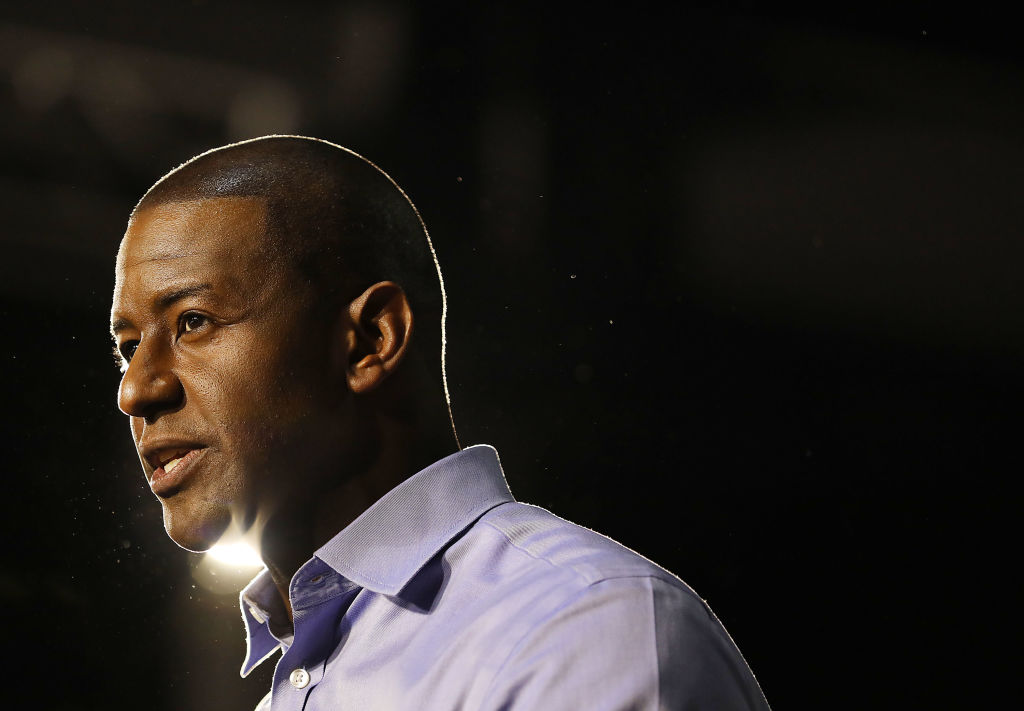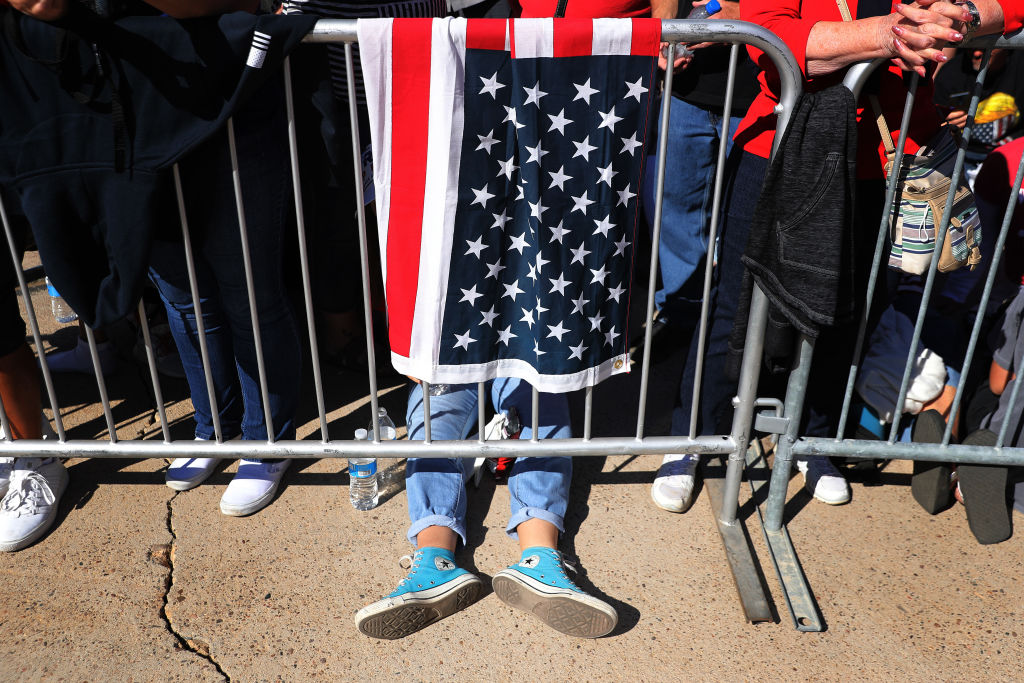This story first appeared in The Guardian and is co-published here as part of the United States of Inequality series.
When Donald Trump beat Hillary Clinton by fewer than 113,000 of the 9.4 million votes cast in Florida’s 2016 presidential election, it came as little surprise in a state accustomed to razor-thin margins. Memories of the 2000 cliffhanger and Bush’s 537-vote victory over Al Gore were still fresh, after all.
But when lightning struck again in the 2018 midterms and both of the Democratic Party’s candidates for state governor and the U.S. Senate were edged out after close recounts, it was time for some profound introspection.
Weary of being perpetual runners-up in state and national races (Barack Obama’s two victories aside) the state’s Democratic Party leaders convened a top-level war council to plot strategy for the 2020 presidential election, now just 12 months away.
From a target of registering hundreds of thousands of new voters to earlier and better on-the-ground canvassing, and from investing millions of dollars in recruiting local organizers and more finely focused outreach efforts on a sizeable Hispanic and African-American communities, Democrats are going all-out to reverse the notion that Florida is unassailable Trump country.
“In a lot of ways, 2016 was kind of self-inflicted,” said Gary Farmer, a state senator and leader designate of the Democratic caucus in Tallahassee who has the reins of the party’s campaign fundraising committee.
“There was a great sense of dissatisfaction amongst a lot of Democratic voters after the primary. A lot of them stayed home, a lot of them voted for Trump as a protest, so you look at the turnout and adjust it for population growth, it’s one of the lowest turnouts we’ve ever had.
“We can’t make that mistake again. Vote for who you want in the primary, but come together afterwards.”
His message of unity resonated at the party’s state convention in October, when about 1,500 Democrats, from elected politicians to grass-roots voters, descended on Disney World in Orlando to talk tactics.
“Whoever the Democrats put up, whether it’s Biden or Mickey Mouse, we have to vote Democrat,” one attendee noted, with a nod to his surroundings.
Ultimately, however, party leaders agree it will take more than just the unquestioned loyalty of existing supporters to turn Florida blue. New voters are needed, lots of them, and in May the party announced a “monumental” $2 million investment to register 200,000 statewide before the 2020 election.
“It’s about making the electorate we need versus the electorate the public says we have,” said Terrie Rizzo, chair of the Florida Democratic Party.
“It’s about building our base again, if you will. But to get 200,000 new Democrats takes a lot of effort, and we’re investing in a number of programs.”
How this looks on the ground is a sea of new faces – young and enthusiastic activists and volunteers, from diverse backgrounds and often with deep knowledge of their own neighborhoods and issues. Many are students, active in Florida’s numerous university campuses.
Inside the Democratic Party, they work under a network of field organizers, a newly expanded team of dozens of paid recruits responsible for community engagement and voter registration and education on a region by region basis. Florida is one of the seven key battleground states targeted by Democrats nationally as part of their Organizing Corps 2020 campaign launched earlier this year.
“It’s programming so people hear our message in all 67 of Florida’s counties, and in all our communities,” Rizzo said. “LBGTQ voters, people living with disabilities, Hispanic and Latino voters, African-Americans, not just binary voters, understanding what the Democratic Party stands for and why our ideas our better, how we bring stability to the country and especially in Florida.
“In Palm Beach county we have passed 400,000 Democrats for the first time ever. We are out-registering the Republicans and pulling away. And that’s a blue county, the Republicans are making an effort there, that’s the home of Mar-a-Lago.”
Prominent Democratic figures are also in the thick of the fight, including Andrew Gillum, the former Tallahassee mayor who lost the 2018 election for state governor to Republican Ron DeSantis.
Gillum, seen as a rising star of the Democratic party, leads Forward Florida Action, a progressive voter registration organization that has an even more ambitious target – registering and reengaging one million Florida voters before November 2020.
“Neighbors talking to neighbors, that’s how we’re going to empower everyday Floridians to flip Florida blue,” said Rosy Gonzalez Speers, the group’s executive director.
For those already knocking on Floridians’ doors, the key issues are clear.
“The first thing is healthcare, then affordable housing and jobs and the economy,” said Melanie McRae, a Miami-based electoral field organizer for New Florida Majority, an independent political action and advocacy group that works mostly with “marginalized and excluded” communities.
“Unemployment is higher amongst people of color so even when you have the lowest jobless rate that we’ve seen historically, you still have a higher number of people of color who can’t find work, or can’t find consistent full-time living wages.
“So of course it’s jobs, getting a living wage, being able to take the relatively low wages that unskilled or minimally skilled labor will be able to get, and translating that into quality, affordable, safe housing. That’s very difficult in Miami.”
Besides New York, there is no other U.S. city more familiar with the challenges of income inequality. A study published in April by the Miami Urban Future Initiative, a collaboration between Florida International University and urban researchers at the Creative Class Group, found that there were stark racial dimensions to the city’s high rate of poverty.
Specifically, it found that 14.3 percent of Miami residents lived in poverty, affecting African-Americans and Hispanics at a rate of two and a half to almost two times more than white families respectively. Many in Miami, and other tourist-rich areas of Florida such as Orlando and Tampa, work in lower-paid, service-industry jobs including hotel, retail and food service.
In Orlando, the median service-class wage is $24,057, the lowest in the nation according to the 2017 U.S. Census community survey, and in Miami it was little higher at $26,532.
“It’s hard sometimes times just to make the rent,” said Maria Medina, a second-generation Cuban-American and mother of two elementary school-aged children from Little Havana. She works two part-time jobs: a morning waitress at a pancake house and afternoons and some evenings as a seamstress for a family-run tailor’s shop on Calle Ocho.
Medina, 34, said many of her neighbors and friends are not interested in politics but that she would vote for the Democratic nominee next year, whoever it was.
“Donald Trump has been very bad for the country in many ways,” she said. “He has been horrible for immigration. We need to make sure he is voted out.”
McRae, who organizes small teams of canvassers knocking on up to 100 doors a day in Miami’s ethnically diverse neighborhoods, stresses that her organization is non-partisan. “We are not the Democratic Party, we are not politicians, so we don’t come to ask for your vote, we’re here year-round motivating, educating and advocating for a better Florida,” she said.
But she acknowledges that many of New Florida Majority’s ideals – including racial and social equality, criminal justice reform, care of the environment and tackling climate change – are shared by most Democrats, and will be huge motivating factors for voters in next year’s election.
“What I’m getting from voters is anger, disgust, a little bit of hopelessness, which we’re trying to use as fuel to get them out,” she said. “We’re not preparing for 2020. 2020 is already here.”
Rizzo, the state party’s chair, accepts that Republicans will point to Florida’s booming economy and unemployment rate of 3.2 percent as a reason for sticking with Trump for four more years, but counters that low wages are crippling families.
“Many people are working two or three jobs just to have a decent living,” she said.
“Educating voters so they know the issues is going to be critical. Healthcare is number one for Floridians and Republicans are attempting to wipe out the Affordable Care Act. The environment is another huge issue where Democrats are full of positive change, while the Trump administration wants to have offshore drilling off Florida.
“Once people figure out who’s doing what, that can be very motivating.”
Ultimately, as in so many recent elections, the result in Florida is going to be a simple numbers game. The party that engages and recruits more supporters will carry off the state’s 29 Electoral College votes, and with them likely the White House.
“It’s why we’re working harder, and earlier, than ever before,” Rizzo said. “They used to call us the one percent state. Now we’re the half-percent state.”
Photo by Joe Raedle/Getty Images
Copyright Capital & Main





